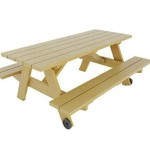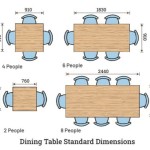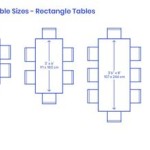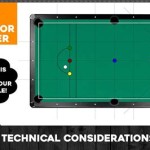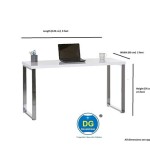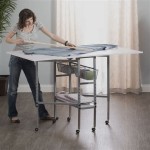Drop Down Dining Tables: Space-Saving Solutions for Modern Living
In contemporary living environments, optimizing available space is paramount. Multifunctional furniture pieces have emerged as popular solutions, catering to the demands of smaller apartments, condominiums, and homes where square footage is a premium. Drop down dining tables represent a significant advancement in this category, offering a practical and aesthetically pleasing way to accommodate dining needs without permanently occupying valuable floor space.
These tables, characterized by their ability to fold down or collapse against a wall or into a cabinet, provide a flexible dining area that can be readily deployed when required and discreetly stowed away when not in use. This adaptability makes them an ideal choice for individuals and families who value efficient space utilization and seek to maintain a clean and uncluttered living environment.
The functionality and design of drop down dining tables vary, encompassing a wide range of styles, materials, and mechanisms. From simple wall-mounted fold-down designs to more elaborate cabinet-integrated systems, the options available cater to diverse aesthetic preferences and spatial constraints. Understanding the key features and benefits of these tables is crucial for making an informed purchasing decision that aligns with individual needs and lifestyle.
Space Optimization and Versatility
The primary advantage of drop down dining tables lies in their unparalleled space-saving capabilities. In compact apartments or multi-purpose rooms, a traditional dining table can consume a significant portion of the available area, restricting movement and limiting the flexibility of the space. A drop down table, however, remains unobtrusive when not in use, allowing the room to serve other functions, such as a living area, home office, or playroom.
The versatility of these tables extends beyond their space-saving attributes. Many designs incorporate additional features, such as built-in storage compartments, shelving, or even dual-purpose mechanisms that allow the table to transform into a desk or workspace. This adaptability makes them exceptionally valuable for individuals who require a multifunctional furniture piece that can adapt to their evolving needs.
Furthermore, the ability to quickly and easily deploy or stow away the table offers considerable convenience. Whether hosting a spontaneous dinner party or simply needing extra surface space for a project, the table can be readily accessed and set up in a matter of seconds. This ease of use makes drop down dining tables a practical and user-friendly solution for modern lifestyles.
Consider the common scenario of a small apartment dweller who enjoys hosting occasional gatherings. A traditional dining table would permanently occupy a significant portion of their limited living space. With a drop down dining table, they can maximize the available room for everyday activities and effortlessly transform the area into a dining space when guests arrive. This adaptability enhances the overall functionality and livability of the apartment.
Another example is a studio apartment where the living, dining, and working areas are often combined. A drop down dining table can serve as a dual-purpose surface, functioning as a dining table during mealtimes and a desk during work hours. This eliminates the need for separate dedicated furniture pieces, further optimizing space utilization.
Design and Aesthetic Considerations
While functionality remains a key consideration, the aesthetic appeal of a drop down dining table is equally important. These tables are available in a wide array of designs, materials, and finishes, allowing homeowners to seamlessly integrate them into their existing décor. The selection process involves considering the overall style of the room, the desired color palette, and the preferred materials.
Modern designs often feature sleek, minimalist aesthetics, incorporating materials such as metal, glass, and engineered wood. These tables tend to blend seamlessly into contemporary living spaces, adding a touch of sophistication and elegance. Traditional designs, on the other hand, may incorporate warmer materials such as solid wood and feature more intricate detailing, complementing classic or rustic interior styles.
The mounting mechanism and folding hardware are also crucial design elements. Concealed hinges and smooth, effortless folding actions contribute to a refined and seamless appearance. The table should appear aesthetically pleasing both when deployed and when stowed away, maintaining the overall visual harmony of the room.
Beyond the table itself, the surrounding area can be designed to enhance its functionality and aesthetic appeal. Adding decorative elements such as wall art, shelving, or lighting can create a cohesive and inviting dining space that complements the table's design. The overall goal is to create a functional and visually appealing area that serves as both a dining space and an integral part of the living environment.
Careful attention to detail, such as selecting coordinating chairs and tableware, can further enhance the dining experience. The chairs should be comfortable and aesthetically pleasing, complementing the table's style and finish. The tableware should reflect the homeowner's personal taste and contribute to the overall ambiance of the dining space.
Color plays a vital role in setting the mood and atmosphere of the dining area. Neutral colors, such as whites, grays, and beiges, create a calming and sophisticated ambiance, while bolder colors, such as blues, greens, and reds, can add a touch of energy and vibrancy. The choice of color should be carefully considered, taking into account the overall style of the room and the homeowner's personal preferences.
Installation and Structural Integrity
Proper installation is paramount to ensure the safety and functionality of a drop down dining table. The table must be securely mounted to a sturdy wall or structural element to prevent accidental collapse or movement. The installation process often involves using specialized hardware and techniques, depending on the type of wall and the table's design.
For wall-mounted designs, it is essential to identify the wall studs or joists and use appropriate anchors to secure the table's mounting brackets. The weight capacity of the wall and the anchors should be carefully considered to ensure that the table can safely support the intended load. In some cases, it may be necessary to reinforce the wall or consult with a professional installer to ensure structural integrity.
Cabinet-integrated drop down dining tables typically require professional installation to ensure proper alignment and functionality. The cabinet must be securely anchored to the wall or floor, and the folding mechanism must be precisely adjusted to ensure smooth and effortless operation. Professional installation can also help to prevent damage to the cabinet or the surrounding area.
The structural integrity of the table itself is equally important. The table should be constructed from high-quality materials that can withstand the rigors of regular use. The folding mechanism should be durable and reliable, ensuring that the table can be safely deployed and stowed away countless times without failure. Regular maintenance, such as tightening screws and lubricating hinges, can help to prolong the lifespan of the table and maintain its structural integrity.
Before purchasing a drop down dining table, it is essential to carefully assess the weight capacity and structural limitations. The table should be able to safely support the weight of the plates, utensils, and food that will be placed on it. Overloading the table can compromise its structural integrity and potentially lead to accidents.
In addition to the weight capacity, it is also important to consider the table's overall stability. The table should be stable and level when deployed, preventing food or drinks from spilling. Adjustable feet or leveling mechanisms can help to compensate for uneven floors and ensure a stable dining surface.
Choosing a drop down dining table requires careful consideration of space requirements, design preferences, and structural integrity. By understanding these key factors, individuals can select a table that meets their specific needs and enhances the functionality and aesthetics of their living space.

Kitchen Dining Tables Drop Leaf Table Space Saving Murphy Down Desk Wall Mount Hanging Workstation

Cherry Drop Leaf Dining Table

Box Frame Drop Leaf Expandable Table 61 Cm 122 West Elm

Oval Drop Leaf Dining Table Tables I Jl Brown Ltd

Modern Drop Leaf Sofa Console Dining Table

Space Saving Dining Table Ideas For Your Home Design Cafe

Introducing Drop Leaf Dining Tables The Good Old Space Savers Table Rectangular Room

Handmade Folding Fold Down Dining Table Half Moon Drop Leaf Kitchen Oval Circular Semi Circle Natural Solid Wood Custom Sized

Tms Chadwick 40 Round Solid Wood Drop Leaf Dining Table Midnight Blue Com

Steve Silver Furniture Dining Tables Abaco Ab200 Drop Leaf Table Round From City Nm

